VOLVO XC90 TWIN ENGINE 2018 Owners Manual
Manufacturer: VOLVO, Model Year: 2018, Model line: XC90 TWIN ENGINE, Model: VOLVO XC90 TWIN ENGINE 2018Pages: 686, PDF Size: 17 MB
Page 321 of 686
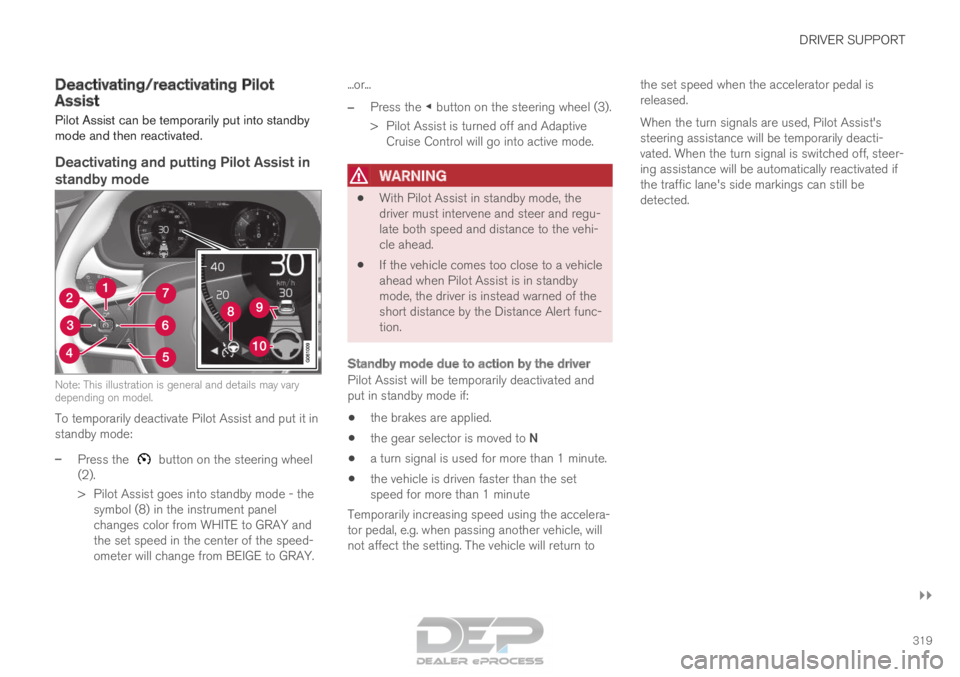
DRIVER SUPPORT
}}
319
Deactivating/reactivating Pilot
Assist
Pilot Assist
can be temporarily put into standby
mode and then reactivated.
Deactivating and putting Pilot Assist in
standby mode Note: This illustration is general and details may vary
depending on model.
To temporarily deactivate Pilot Assist and put it in
standby mode:
–
Press the button on the steering wheel
(2).
>
Pilot Assist goes into standby mode - the
symbol (8) in the instrument panel
changes color from WHITE to GRAY and
the set speed in the center of the speed-
ometer will change from BEIGE to GRAY. ...or...
– Press the ◀ button on the steering wheel (3).
>
Pilot Assist is turned off and Adaptive
Cruise Control will go into active mode.
WARNING •
With Pilot Assist in standby mode, the
driver must intervene and steer and regu-
late both speed and distance to the vehi-
cle ahead.
• If the vehicle comes too close to a vehicle
ahead when Pilot Assist is in standby
mode, the driver is instead warned of the
short distance by the Distance Alert func-
tion.
Standby mode due to action by the driver
Pilot Assist will be temporarily deactivated and
put in standby mode if:
• the brakes are applied.
• the gear selector is moved to N
• a turn signal is used for more than 1 minute.
• the vehicle is driven faster than the set
speed for more than 1 minute
Temporarily increasing speed using the accelera-
tor pedal, e.g. when passing another vehicle, will
not affect the setting. The vehicle will return to the set speed when the accelerator pedal is
released.
When the turn signals are used, Pilot Assist's
steering assistance will be temporarily deacti-
vated. When the turn signal is switched off, steer-
ing assistance will be automatically reactivated if
the traffic lane's side markings can still be
detected.
Page 322 of 686
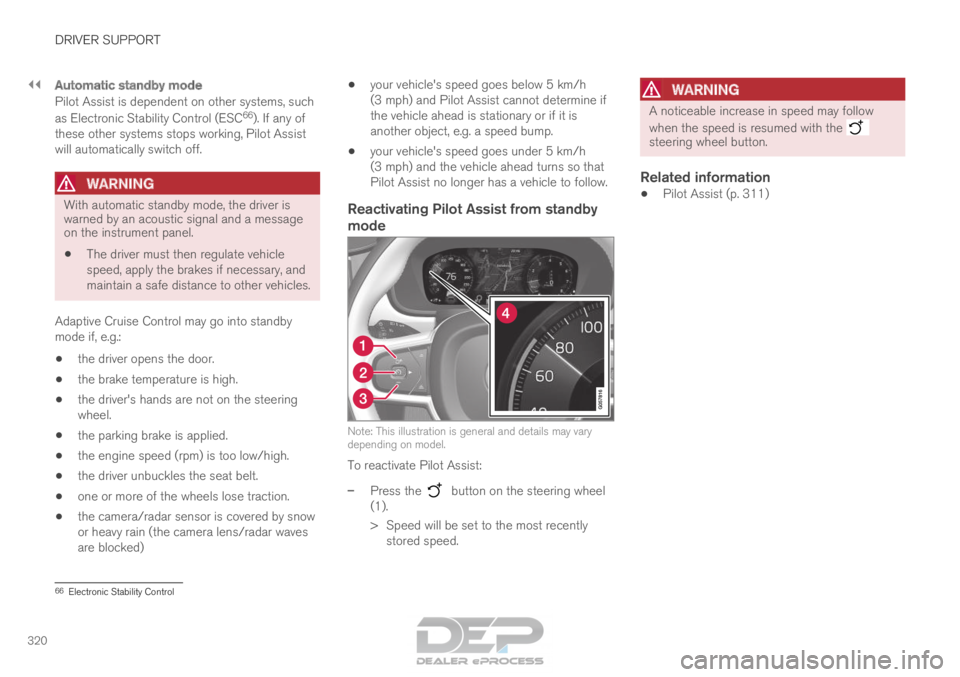
||DRIVER SUPPORT
320
Automatic standby mode
Pilot Assist is dependent on other systems, such
as Electronic Stability Control (ESC
66
). If any of
these other systems stops working, Pilot Assist
will automatically switch off.
WARNING With automatic standby mode, the driver is
warned by an acoustic signal and a message
on the instrument panel.
•
The driver must then regulate vehicle
speed, apply the brakes if necessary, and
maintain a safe distance to other vehicles.
Adaptive Cruise Control may go into standby
mode if, e.g.:
• the driver opens the door.
• the brake temperature is high.
• the driver's hands are not on the steering
wheel.
• the parking brake is applied.
• the engine speed (rpm) is too low/high.
• the driver unbuckles the seat belt.
• one or more of the wheels lose traction.
• the camera/radar sensor is covered by snow
or heavy rain (the camera lens/radar waves
are blocked) •
your vehicle's speed goes below 5 km/h
(3 mph) and Pilot Assist cannot determine if
the vehicle ahead is stationary or if it is
another object, e.g. a speed bump.
• your vehicle's speed goes under 5 km/h
(3 mph) and the vehicle ahead turns so that
Pilot Assist no longer has a vehicle to follow.
Reactivating Pilot Assist from standby
mode Note: This illustration is general and details may vary
depending on model.
To reactivate Pilot Assist:
–
Press the button on the steering wheel
(1).
>
Speed will be set to the most recently
stored speed.
WARNING A noticeable increase in speed may follow
when the speed is resumed with the
steering wheel button.
Related information
•
Pilot Assist (p. 311) 66
Electronic Stability Control
Page 323 of 686
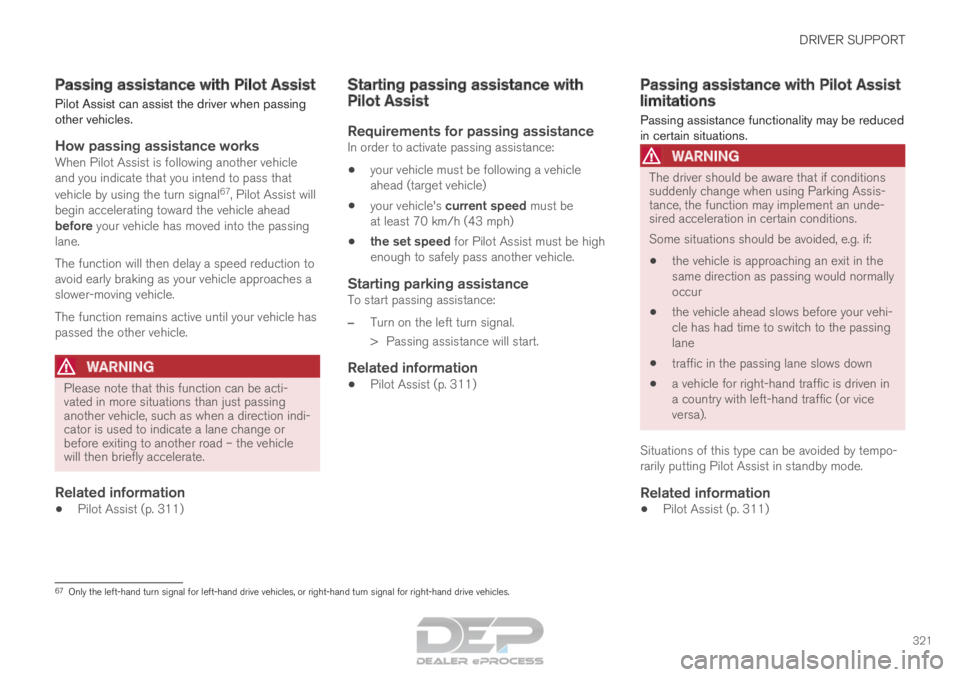
DRIVER SUPPORT
321
Passing assistance with Pilot Assist
Pilot Assist can assist the driver when passing
other vehicles.
How passing assistance worksWhen Pilot Assist is following another vehicle
and you indicate that you intend to pass that
vehicle by using the turn signal 67
, Pilot Assist will
begin accelerating toward the vehicle ahead
before your vehicle has moved into the passing
lane.
The function will then delay a speed reduction to
avoid early braking as your vehicle approaches a
slower-moving vehicle.
The function remains active until your vehicle has
passed the other vehicle.
WARNING Please note that this function can be acti-
vated in more situations than just passing
another vehicle, such as when a direction indi-
cator is used to indicate a lane change or
before exiting to another road – the vehicle
will then briefly accelerate.
Related information
•
Pilot Assist (p. 311) Starting passing assistance with
Pilot Assist
Requirements for passing assistanceIn order to activate passing assistance:
• your vehicle must be following a vehicle
ahead (target vehicle)
• your vehicle's current speed must be
at least 70 km/h (43 mph)
• the set speed for Pilot Assist must be high
enough to safely pass another vehicle.
Starting parking assistanceTo start passing assistance:
–
Turn on the left turn signal.
>
Passing assistance will start.
Related information
• Pilot Assist (p. 311) Passing assistance with Pilot Assist
limitations
Passing assistance functionality may be reduced
in certain situations.
WARNING The driver should be aware that if conditions
suddenly change when using Parking Assis-
tance, the function may implement an unde-
sired acceleration in certain conditions.
Some situations should be avoided, e.g. if:
•
the vehicle is approaching an exit in the
same direction as passing would normally
occur
• the vehicle ahead slows before your vehi-
cle has had time to switch to the passing
lane
• traffic in the passing lane slows down
• a vehicle for right-hand traffic is driven in
a country with left-hand traffic (or vice
versa).
Situations of this type can be avoided by tempo-
rarily putting Pilot Assist in standby mode.
Related information
• Pilot Assist (p. 311) 67
Only the left-hand turn signal for left-hand drive vehicles, or right-ha\
nd turn signal for right-hand drive vehicles.
Page 324 of 686

DRIVER SUPPORT
322Switching target vehicles with Pilot
Assist
At certain speeds, models with automatic trans-
missions and
Pilot Assist can switch target vehi-
cles.
Switching target vehicles If the target vehicle ahead turns suddenly, there may be
stationary traffic ahead.
When Pilot Assist is actively following another
vehicle at speeds under 30 km/h (20 mph) and
switches targets from a moving vehicle to a sta-
tionary vehicle,
Pilot Assist will brake for the sta-
tionary vehicle.
WARNING When Pilot Assist follows another vehicle at
speeds over approx. 30 km/h (20 mph) and
changes target vehicle – from a moving vehi-
cle to a stationary one – Pilot Assist will
ignore the stationary vehicle and instead
accelerate to the stored speed.
• The driver must then intervene and apply
the brakes.
Automatic standby mode when switching
targets
Pilot Assist disengages and goes into standby
mode if:
• your vehicle's speed goes below 5 km/h
(3 mph) and Pilot Assist cannot determine if
the target object is a stationary vehicle or
another object, e.g. a speed bump.
• your vehicle's speed goes under 5 km/h
(3 mph) and the vehicle ahead turns so that
Pilot Assist no longer has a vehicle to follow.
Related information
•Pilot Assist (p. 311) Automatic braking with Pilot Assist
Pilot Assist has a special braking function in
slow traffic and at a standstill.
Braking function in slow traffic and at a
standstill
In slow-moving, stop-and-go traffic or when stop-
ped at a traffic light, driving will resume automati-
cally if the vehicle is stopped for less than
approx. 3 seconds. If it takes more than 3 sec-
onds for the vehicle ahead to begin moving again,
Pilot Assist will go into standby mode and the
Auto-hold brake function will activate.
– Pilot Assist can be reactivated by:
• Pressing the button on the steering
wheel keypad.
• Pressing the accelerator pedal.
>
Pilot Assist will resume following the vehi-
cle ahead if it begins to move within
approx. 6 seconds.
NOTE Pilot Assist can keep the vehicle stationary
for no more than 5 minutes – after that time
the parking brake is applied and the function
is deactivated.
The parking brake must be released before
Pilot Assist can be reactivated.
Page 325 of 686
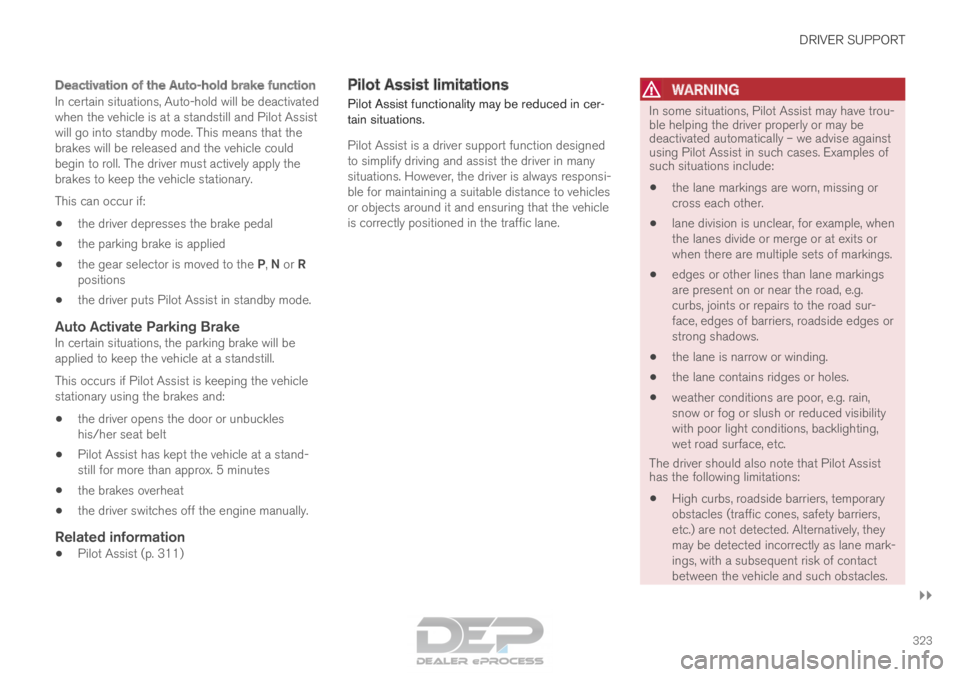
DRIVER SUPPORT
}}}}
323
Deactivation of the Auto-hold brake function
In certain situations, Auto-hold will be deactivated
when the vehicle is at a standstill and Pilot Assist
will go into standby mode. This means that the
brakes will be released and the vehicle could
begin to roll. The driver must actively apply the
brakes to keep the vehicle stationary.
This can occur if:
• the driver depresses the brake pedal
• the parking brake is applied
• the gear selector is moved to the P, N or R
positions
• the driver puts Pilot Assist in standby mode.
Auto Activate Parking BrakeIn certain situations, the parking brake will be
applied to keep the vehicle at a standstill.
This occurs if Pilot Assist is keeping the vehicle
stationary using the brakes and:
• the driver opens the door or unbuckles
his/her seat belt
• Pilot Assist has kept the vehicle at a stand-
still for more than approx. 5 minutes
• the brakes overheat
• the driver switches off the engine manually.
Related information
•Pilot Assist (p. 311) Pilot Assist limitations
Pilot Assist functionality may be reduced in cer-
tain situations.
Pilot Assist is a driver support function designed
to simplify driving and assist the driver in many
situations. However, the driver is always responsi-
ble for maintaining a suitable distance to vehicles
or objects around it and ensuring that the vehicle
is correctly positioned in the traffic lane.
WARNING In some situations, Pilot Assist may have trou-
ble helping the driver properly or may be
deactivated automatically – we advise against
using Pilot Assist in such cases. Examples of
such situations include:
• the lane markings are worn, missing or
cross each other.
• lane division is unclear, for example, when
the lanes divide or merge or at exits or
when there are multiple sets of markings.
• edges or other lines than lane markings
are present on or near the road, e.g.
curbs, joints or repairs to the road sur-
face, edges of barriers, roadside edges or
strong shadows.
• the lane is narrow or winding.
• the lane contains ridges or holes.
• weather conditions are poor, e.g. rain,
snow or fog or slush or reduced visibility
with poor light conditions, backlighting,
wet road surface, etc.
The driver should also note that Pilot Assist
has the following limitations:
• High curbs, roadside barriers, temporary
obstacles (traffic cones, safety barriers,
etc.) are not detected. Alternatively, they
may be detected incorrectly as lane mark-
ings, with a subsequent risk of contact
between the vehicle and such obstacles.
Page 326 of 686
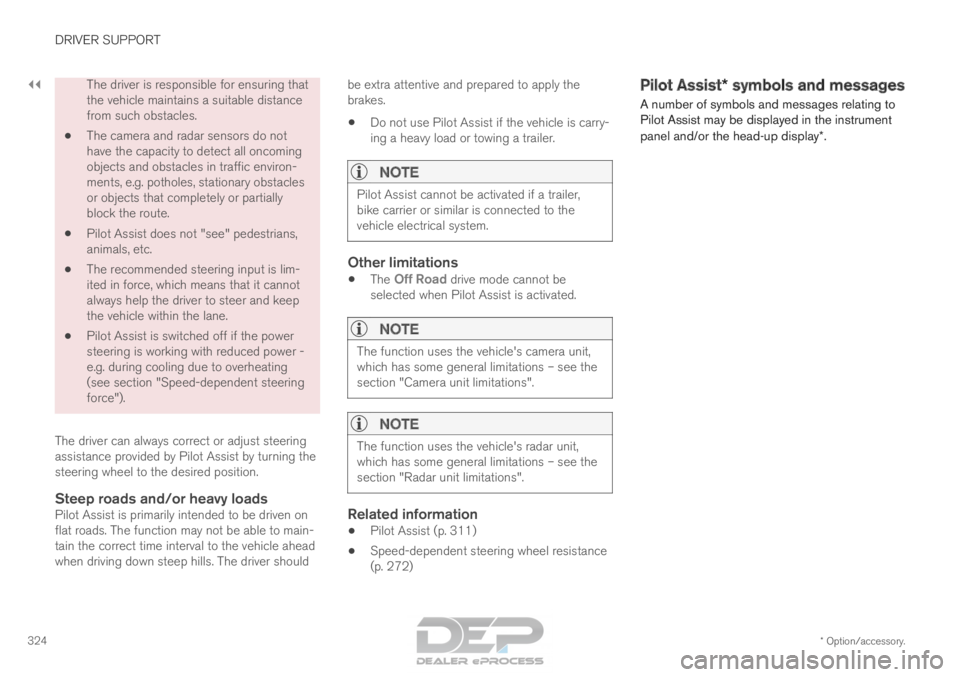
||DRIVER SUPPORT
* Option/accessory.
324 The driver is responsible for ensuring that
the vehicle maintains a suitable distance
from such obstacles.
• The camera and radar sensors do not
have the capacity to detect all oncoming
objects and obstacles in traffic environ-
ments, e.g. potholes, stationary obstacles
or objects that completely or partially
block the route.
• Pilot Assist does not "see" pedestrians,
animals, etc.
• The recommended steering input is lim-
ited in force, which means that it cannot
always help the driver to steer and keep
the vehicle within the lane.
• Pilot Assist is switched off if the power
steering is working with reduced power -
e.g. during cooling due to overheating
(see section "Speed-dependent steering
force").
The driver can always correct or adjust steering
assistance provided by Pilot Assist by turning the
steering wheel to the desired position.
Steep roads and/or heavy loadsPilot Assist is primarily intended to be driven on
flat roads. The function may not be able to main-
tain the correct time interval to the vehicle ahead
when driving down steep hills. The driver should be extra attentive and prepared to apply the
brakes.
• Do not use Pilot Assist if the vehicle is carry-
ing a heavy load or towing a trailer.
NOTE Pilot Assist cannot be activated if a trailer,
bike carrier or similar is connected to the
vehicle electrical system.
Other limitations
•
The
Off Road drive mode cannot be
selected when Pilot Assist is activated.
NOTE The function uses the vehicle's camera unit,
which has some general limitations – see the
section "Camera unit limitations".
NOTE
The function uses the vehicle's radar unit,
which has some general limitations – see the
section "Radar unit limitations".
Related information
•
Pilot Assist (p. 311)
• Speed-dependent steering wheel resistance
(p. 272) Pilot Assist* symbols and messages
A number of symbols and messages relating to
Pilot Assist may be displayed in the instrument
panel and/or the head-up display*.
Page 327 of 686
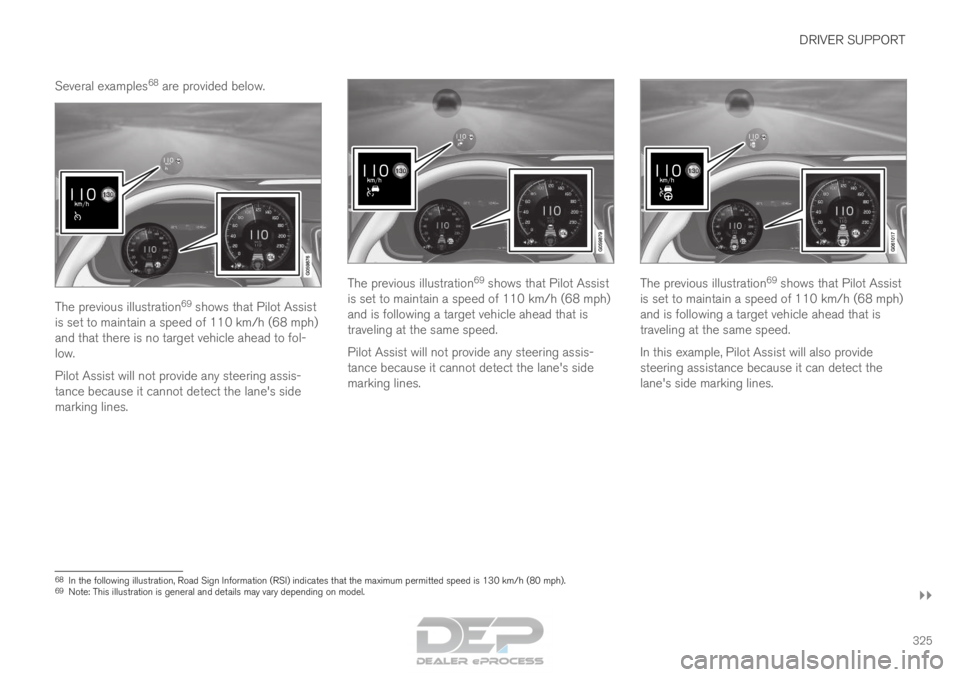
DRIVER SUPPORT
}}
325
Several examples
68
are provided below. The previous illustration
69
shows that Pilot Assist
is set to maintain a speed of 110 km/h (68 mph)
and that there is no target vehicle ahead to fol-
low.
Pilot Assist will not provide any steering assis-
tance because it cannot detect the lane's side
marking lines. The previous illustration
69
shows that Pilot Assist
is set to maintain a speed of 110 km/h (68 mph)
and is following a target vehicle ahead that is
traveling at the same speed.
Pilot Assist will not provide any steering assis-
tance because it cannot detect the lane's side
marking lines. The previous illustration
69
shows that Pilot Assist
is set to maintain a speed of 110 km/h (68 mph)
and is following a target vehicle ahead that is
traveling at the same speed.
In this example, Pilot Assist will also provide
steering assistance because it can detect the
lane's side marking lines. 68
In the following illustration, Road Sign Information (RSI) indicates t\
hat the maximum permitted speed is 130 km/h (80 mph).
69 Note: This illustration is general and details may vary depending on mod\
el.
Page 328 of 686

||DRIVER SUPPORT
* Option/accessory.
326 The previous illustration
69
shows that Pilot Assist
is set to maintain a speed of 110 km/h (68 mph)
and that there is no target vehicle ahead to fol-
low.
In this example, Pilot Assist will provide steering
assistance because it can detect the lane's side
marking lines.
Related information
• Pilot Assist (p. 311) Radar sensor
The radar sensor is used by several driver sup-
port systems to detect other vehicles. Note: This illustration is general and details may vary
depending on model.
The radar sensor is used by the following func-
tions:
• Distance Alert*
• Adaptive Cruise Control*
• Lane Keeping Aid
• Pilot Assist*
• City Safety
Any modifications to the radar sensor may make
its use illegal.
Related information
• Radar sensor limitations (p. 327)
• Recommended maintenance for the radar
sensor (p. 330)
• Radar sensor type approval (p. 330) 69
Note: This illustration is general and details may vary depending on mod\
el.
Page 329 of 686
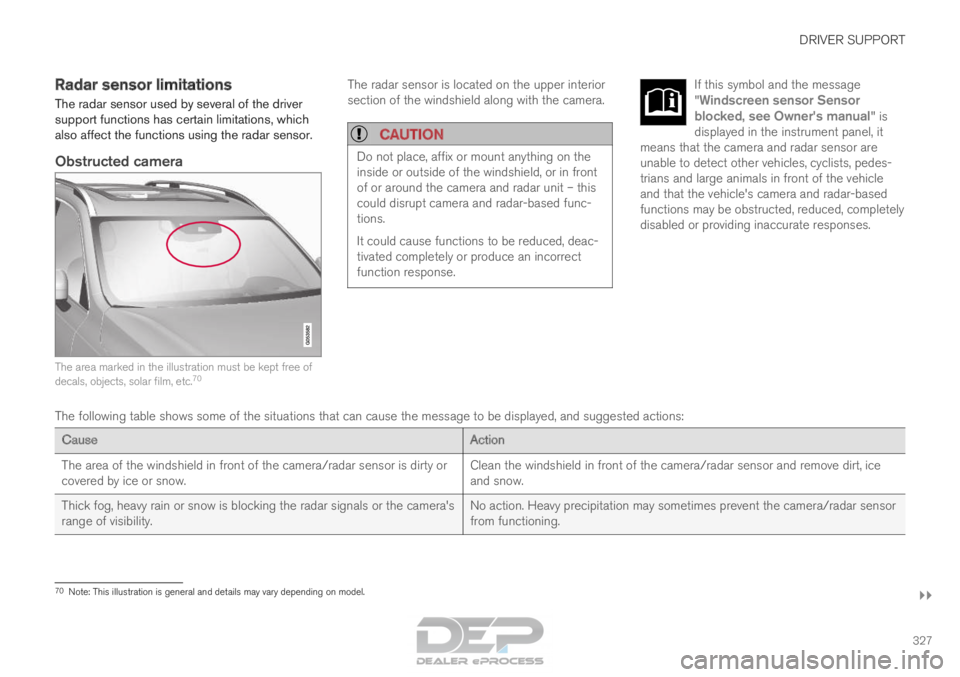
DRIVER SUPPORT
}}
327
Radar sensor limitations
The radar sensor used by several of the driver
support functions has certain limitations, which
also affect the functions using the radar sensor.
Obstructed camera The area marked in the illustration must be kept free of
decals, objects, solar film, etc.
70 The radar sensor is located on the upper interior
section of the windshield along with the camera.
CAUTION Do not place, affix or mount anything on the
inside or outside of the windshield, or in front
of or around the camera and radar unit – this
could disrupt camera and radar-based func-
tions.
It could cause functions to be reduced, deac-
tivated completely or produce an incorrect
function response. If this symbol and the message
"
Windscreen sensor Sensor
blocked, see Owner's manual" is
displayed in the instrument panel, it
means that the camera and radar sensor are
unable to detect other vehicles, cyclists, pedes-
trians and large animals in front of the vehicle
and that the vehicle's camera and radar-based
functions may be obstructed, reduced, completely
disabled or providing inaccurate responses. The following table shows some of the situations that can cause the mess\
age to be displayed, and suggested actions:
Cause
Action
The area of the windshield in front of the camera/radar sensor is dirty \
or
covered by ice or snow. Clean the windshield in front of the camera/radar sensor and remove dirt\
, ice
and snow.
Thick fog, heavy rain or snow is blocking the radar signals or the camer\
a's
range of visibility. No action. Heavy precipitation may sometimes prevent the camera/radar se\
nsor
from functioning.70
Note: This illustration is general and details may vary depending on mod\
el.
Page 330 of 686
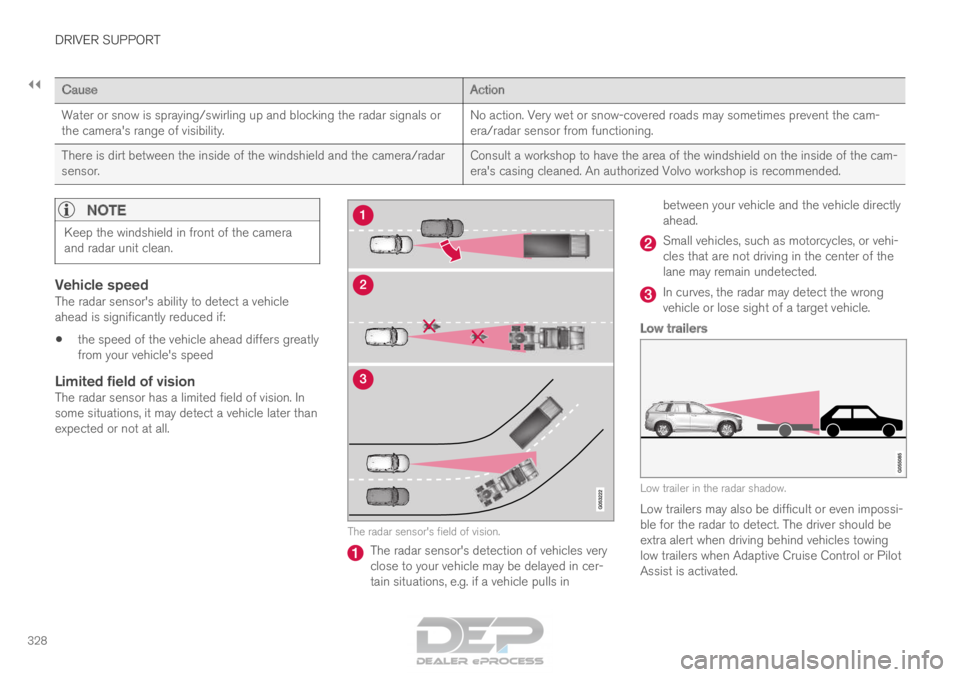
||DRIVER SUPPORT
328
Cause
Action
Water or snow is spraying/swirling up and blocking the radar signals or
the camera's range of visibility. No action. Very wet or snow-covered roads may sometimes prevent the cam-\
era/radar sensor from functioning.
There is dirt between the inside of the windshield and the camera/radar
sensor. Consult a workshop to have the area of the windshield on the inside of t\
he cam-
era's casing cleaned. An authorized Volvo workshop is recommended.
NOTEKeep the windshield in front of the camera
and radar unit clean.
Vehicle speedThe radar sensor's ability to detect a vehicle
ahead is significantly reduced if:
• the speed of the vehicle ahead differs greatly
from your vehicle's speed
Limited field of visionThe radar sensor has a limited field of vision. In
some situations, it may detect a vehicle later than
expected or not at all. The radar sensor's field of vision.
The radar sensor's detection of vehicles very
close to your vehicle may be delayed in cer-
tain situations, e.g. if a vehicle pulls inbetween your vehicle and the vehicle directly
ahead. Small vehicles, such as motorcycles, or vehi-
cles that are not driving in the center of the
lane may remain undetected.
In curves, the radar may detect the wrong
vehicle or lose sight of a target vehicle.
Low trailers
Low trailer in the radar shadow.
Low trailers may also be difficult or even impossi-
ble for the radar to detect. The driver should be
extra alert when driving behind vehicles towing
low trailers when Adaptive Cruise Control or Pilot
Assist is activated.